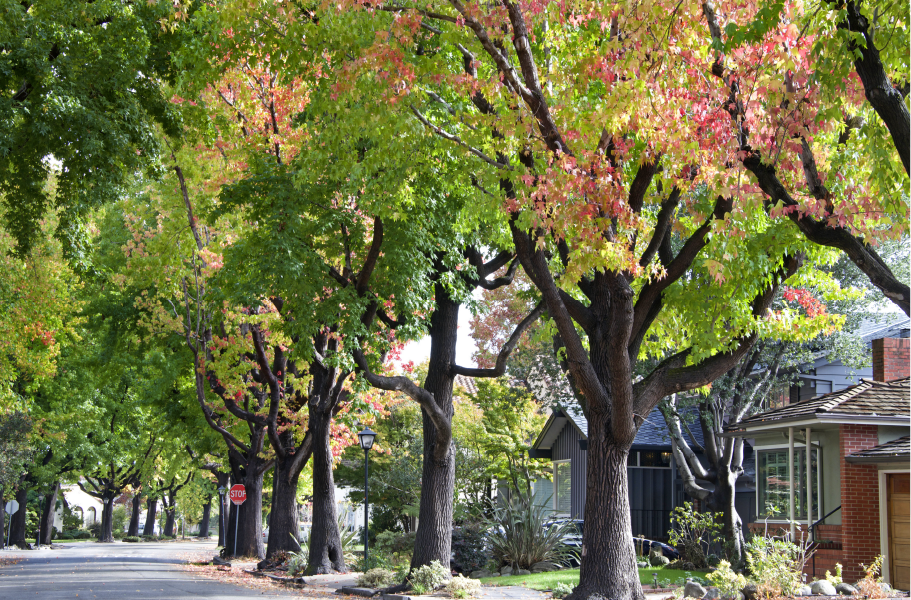Preservation of Tree Canopy Cover
Overwhelming scientific and psychological evidence proves the many benefits of trees in urban environments. Research is also demonstrating that urban tree canopy cover helps in mitigating the global impacts of climate change. As a result, it is now the responsibility of anyone whose actions impact the urban forest canopy to ensure that they do not inflict irreparable harm. Tree Matrix is designed to address this challenge.
Accumulating levels of atmospheric greenhouse gases are attributed to an increase in atmospheric temperatures through the trapping of certain wavelengths of heat. This increase will affect human health and well-being through generally warmer temperatures, and also the resultant changes in weather patterns, rising sea levels and increasingly severe weather events. And because the majority of the world’s population live in urban areas, and most greenhouse gases are emitted from these areas, there is a significant opportunity to mitigate climate change through better urban land use patterns. Most notably, the preservation of existing forest canopy cover.
The net loss in urban canopy cover suggests that existing trees are being lost at a greater rate than new canopy cover can be generated through tree growth, natural regeneration, and tree planting. It is widely accepted, therefore, that canopy preservation is a critical option to sustaining canopy cover. And yet many municipalities lack the proper tools to accurately preserve mature trees during land development.
Average Urban Canopy Cover Predicted to Decline by 7% by 2060
Urban Canopy Decline
An important component of many urban areas, and a critical component of mitigating the impacts of climate change, is forest canopy cover. According to US Forest Service research, the average canopy cover percentage of urban areas in the US today is roughly 40%. Unfortunately, urban forests are projected to decline to 7% in the fifty-year period of 2010 to 2060. This equates to an annual loss of roughly 175,000 acres of canopy cover, or some 36 million trees. Some of this loss can be offset by tree planting, but this is a gradual process. A more significant way of retaining and expanding urban tree cover is the preservation of existing trees.
The net loss in urban canopy cover suggests that existing trees are being lost at a greater rate than new canopy cover can be generated through tree growth, natural regeneration, and tree planting. It is widely accepted, therefore, that canopy preservation is a critical option to sustaining canopy cover. And yet many municipalities lack the proper tools to accurately preserve mature trees during land development.
Municipalities Role in Tree Preservation
Urban Planning
Many municipalities within the urban/suburban interface of the US have adopted tree preservation ordinances. Unfortunately, these methodologies often rely on traditional, but inadequate methods and assumptions. The result is uneven levels of tree preservation success, and an unnecessary loss of existing urban forest canopy. Outdated ordinances often rely on just root zone loss percentage to predict the effectiveness of a tree save plan. And to make matters worse, most tree preservation plans also rely on the assumed and misleading belief that tree roots grow in perfect circles. Shockingly, these two assumptions have guided tree preservation for at least the past 40 years! This amounts to tree preservation through guesswork, and with results that have been predictably disastrous.
Tree Matrix Can Help Mitigate These Challenges
Tree Matrix eliminates that guesswork. It utilizes five equally important parameters based on 35 years of tree preservation experience. And our patented five-parameter algorithm, and ‘root plotting’ software combines to provide the most scientifically accurate level of tree preservation success.
The root plotter acknowledges that barriers to root expansion exist on most building sites. Barriers include structures with deep footings including buildings, retaining walls, and highly engineered roadways. When these barriers are highlighted, and tree characteristics added, the Tree Matrix software calculates the root zone size and likely root zone shape. Rarely are they a perfect circle!
When applying Tree Matrix to preservation planning, municipal governments, landscape architects, engineers, builders and even homeowners can save trees with confidence and subsequently lower regional, national, and global atmospheric temperatures. Visit the website blog section to review sample projects along with narratives that describe how changes were made to increase tree survival likelihoods.
Tree Matrix is the only tool available to provide this level of accuracy in tree preservation planning.
The increasingly obvious threat of climate change makes accurate tree preservation in the urban and suburban environment essential on a global scale. Tree Matrix is the most powerful and modern tool available to help guide tree preservation efforts, and to help in the mitigation of global climate change impacts.
